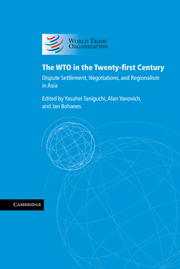Book contents
- Frontmatter
- Contents
- Notes on contributors
- Acknowledgements
- Table of dispute settlement cases and reports
- List of abbreviations
- Introduction
- PART I The WTO at Ten
- PART II Accomplishments and Future Prospects of the WTO Dispute Settlement System
- 3 The WTO dispute settlement system after ten years: the first decade's promises and challenges
- 4 WTO dispute settlement practice 1995–2005: lessons from the past and future challenges
- 5 Evaluating WTO dispute settlement: what results have been achieved through consultations and implementation of panel reports?
- 6 The responsibilities of a WTO Member found to have violated WTO law
- 7 ‘Public–private partnerships’ in WTO dispute settlement: the US and EU experience
- 8 Accomplishments of the WTO dispute settlement mechanism
- 9 Arbitration as an alternative to litigation in the WTO: observations in the light of the 2005 banana tariff arbitrations
- 10 The evolving WTO dispute settlement system
- PART III Asian Perspectives on WTO Dispute Settlement
- PART IV The Doha Development Agenda and Beyond
- PART V Asian Regional Integration and the Multilateral Trading System
- Index
8 - Accomplishments of the WTO dispute settlement mechanism
from PART II - Accomplishments and Future Prospects of the WTO Dispute Settlement System
Published online by Cambridge University Press: 05 March 2012
- Frontmatter
- Contents
- Notes on contributors
- Acknowledgements
- Table of dispute settlement cases and reports
- List of abbreviations
- Introduction
- PART I The WTO at Ten
- PART II Accomplishments and Future Prospects of the WTO Dispute Settlement System
- 3 The WTO dispute settlement system after ten years: the first decade's promises and challenges
- 4 WTO dispute settlement practice 1995–2005: lessons from the past and future challenges
- 5 Evaluating WTO dispute settlement: what results have been achieved through consultations and implementation of panel reports?
- 6 The responsibilities of a WTO Member found to have violated WTO law
- 7 ‘Public–private partnerships’ in WTO dispute settlement: the US and EU experience
- 8 Accomplishments of the WTO dispute settlement mechanism
- 9 Arbitration as an alternative to litigation in the WTO: observations in the light of the 2005 banana tariff arbitrations
- 10 The evolving WTO dispute settlement system
- PART III Asian Perspectives on WTO Dispute Settlement
- PART IV The Doha Development Agenda and Beyond
- PART V Asian Regional Integration and the Multilateral Trading System
- Index
Summary
The Members of the World Trade Organization (WTO) had remarkably ambitious goals for their newly minted dispute settlement system. In the Marrakesh Declaration of 15 April 1994, Ministers ‘salute[d] the historic achievement’ represented by the conclusion of the Uruguay Round, stating that it would ‘strengthen the world economy and lead to more trade, investment, employment and income growth throughout the world.’ Notably, in that same document, Ministers ‘welcomed’ ‘in particular’ the new dispute settlement system. Ministers underlined ‘the stronger and clearer legal framework they [had] adopted for the conduct of international trade, including a more effective and reliable dispute settlement mechanism.’
This pride-of-place enjoyed by dispute settlement in the WTO system stands in marked contrast to the role that dispute settlement considerations played at the Havana Conference in 1947, when the General Agreement on Tariffs and Trade (GATT) came into being. Ambassador Julio Lacarte-Muró, the first Chairman of the Appellate Body, who was present at the Havana Conference, has said that dispute settlement was a minor consideration in 1947 that did not receive much attention. Not surprisingly, therefore, dispute settlement was treated in just two Articles (XXII and XXIII) of the GATT 1947. It could hardly have been more different at the conclusion of the Uruguay Round in 1994. Dispute settlement had clearly become a pivotal element of the Uruguay Round agreements.
- Type
- Chapter
- Information
- The WTO in the Twenty-first CenturyDispute Settlement, Negotiations, and Regionalism in Asia, pp. 185 - 211Publisher: Cambridge University PressPrint publication year: 2007
- 1
- Cited by

